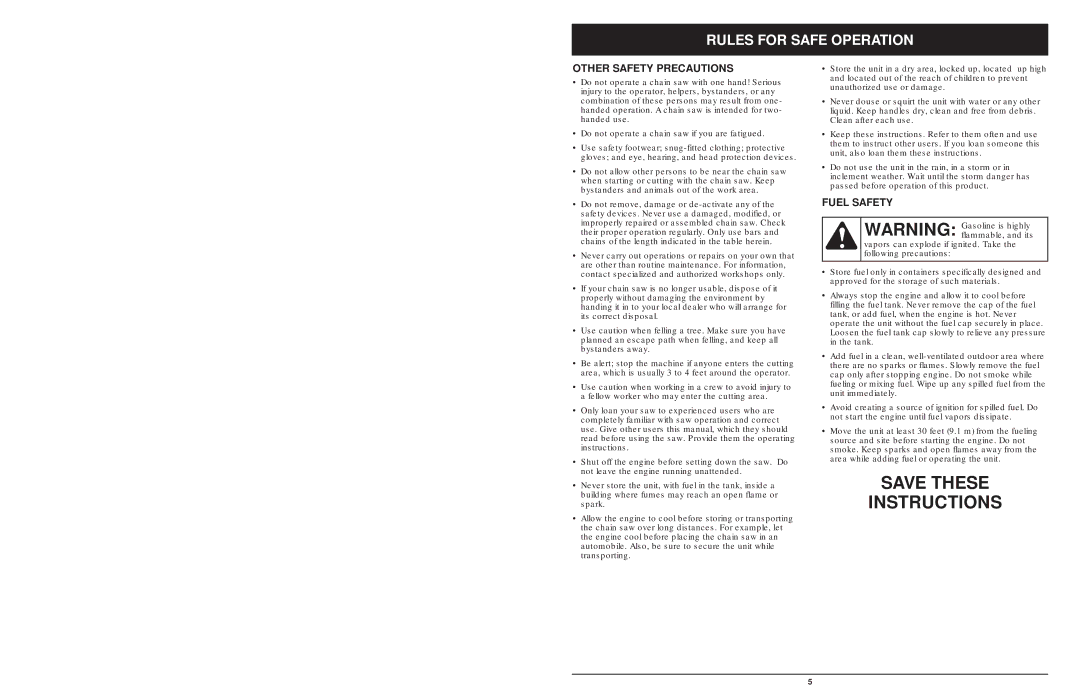
RULES FOR SAFE OPERATION
OTHER SAFETY PRECAUTIONS
•Do not operate a chain saw with one hand! Serious injury to the operator, helpers, bystanders, or any combination of these persons may result from one- handed operation. A chain saw is intended for two- handed use.
•Do not operate a chain saw if you are fatigued.
•Use safety footwear;
•Do not allow other persons to be near the chain saw when starting or cutting with the chain saw. Keep bystanders and animals out of the work area.
•Do not remove, damage or
•Never carry out operations or repairs on your own that are other than routine maintenance. For information, contact specialized and authorized workshops only.
•If your chain saw is no longer usable, dispose of it properly without damaging the environment by handing it in to your local dealer who will arrange for its correct disposal.
•Use caution when felling a tree. Make sure you have planned an escape path when felling, and keep all bystanders away.
•Be alert; stop the machine if anyone enters the cutting area, which is usually 3 to 4 feet around the operator.
•Use caution when working in a crew to avoid injury to a fellow worker who may enter the cutting area.
•Only loan your saw to experienced users who are completely familiar with saw operation and correct use. Give other users this manual, which they should read before using the saw. Provide them the operating instructions.
•Shut off the engine before setting down the saw. Do not leave the engine running unattended.
•Store the unit in a dry area, locked up, located up high and located out of the reach of children to prevent unauthorized use or damage.
•Never douse or squirt the unit with water or any other liquid. Keep handles dry, clean and free from debris. Clean after each use.
•Keep these instructions. Refer to them often and use them to instruct other users. If you loan someone this unit, also loan them these instructions.
•Do not use the unit in the rain, in a storm or in inclement weather. Wait until the storm danger has passed before operation of this product.
FUEL SAFETY
![]()
![]() WARNING: Gasoline is highly flammable, and its
WARNING: Gasoline is highly flammable, and its
vapors can explode if ignited. Take the following precautions:
•Store fuel only in containers specifically designed and approved for the storage of such materials.
•Always stop the engine and allow it to cool before filling the fuel tank. Never remove the cap of the fuel tank, or add fuel, when the engine is hot. Never operate the unit without the fuel cap securely in place. Loosen the fuel tank cap slowly to relieve any pressure in the tank.
•Add fuel in a clean,
•Avoid creating a source of ignition for spilled fuel. Do not start the engine until fuel vapors dissipate.
•Move the unit at least 30 feet (9.1 m) from the fueling source and site before starting the engine. Do not smoke. Keep sparks and open flames away from the area while adding fuel or operating the unit.
•Never store the unit, with fuel in the tank, inside a building where fumes may reach an open flame or spark.
•Allow the engine to cool before storing or transporting the chain saw over long distances. For example, let the engine cool before placing the chain saw in an automobile. Also, be sure to secure the unit while transporting.
SAVE THESE
INSTRUCTIONS
5
